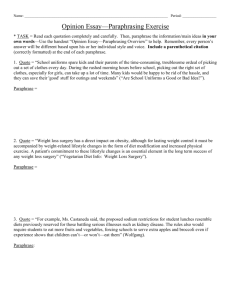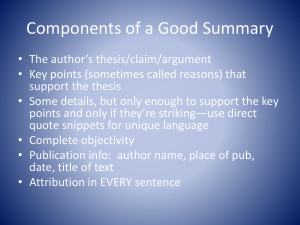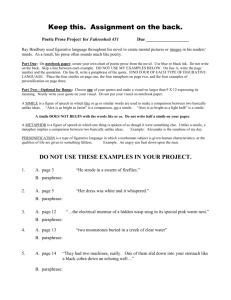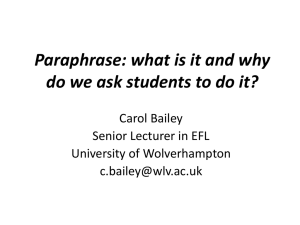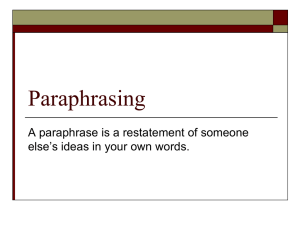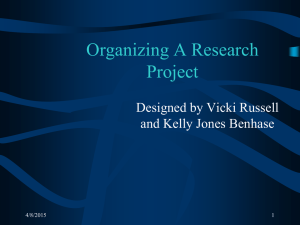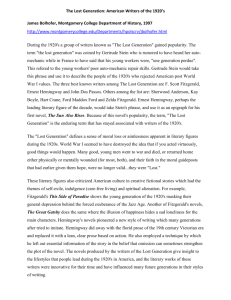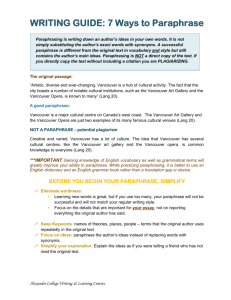Paraphrase Exercise
advertisement
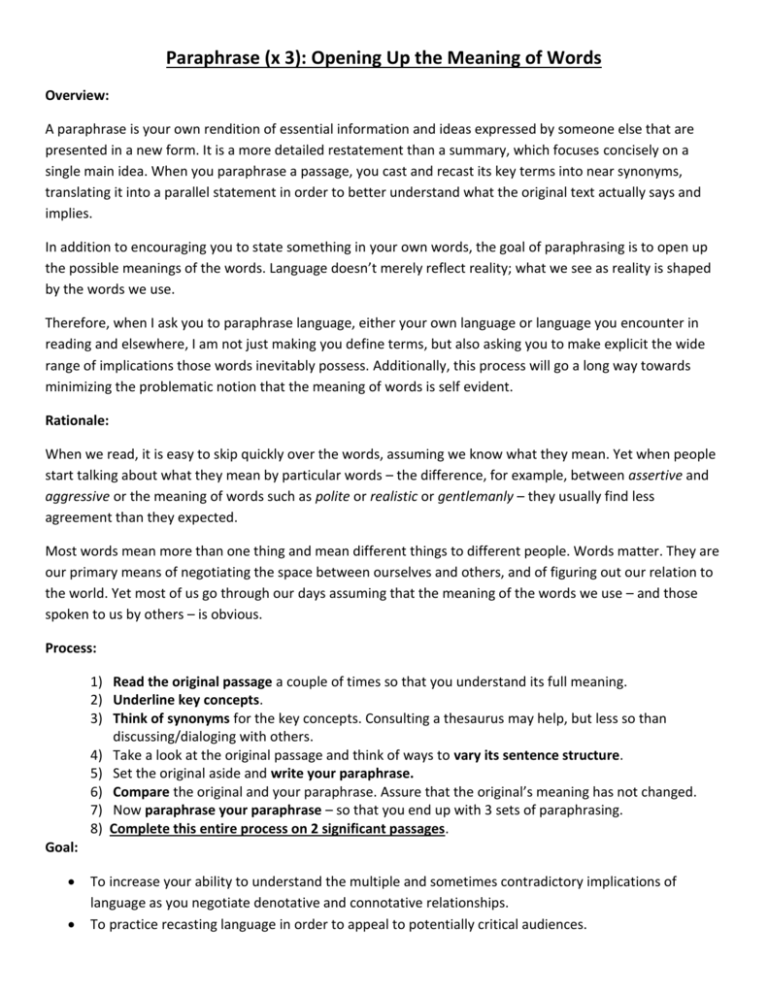
Paraphrase (x 3): Opening Up the Meaning of Words Overview: A paraphrase is your own rendition of essential information and ideas expressed by someone else that are presented in a new form. It is a more detailed restatement than a summary, which focuses concisely on a single main idea. When you paraphrase a passage, you cast and recast its key terms into near synonyms, translating it into a parallel statement in order to better understand what the original text actually says and implies. In addition to encouraging you to state something in your own words, the goal of paraphrasing is to open up the possible meanings of the words. Language doesn’t merely reflect reality; what we see as reality is shaped by the words we use. Therefore, when I ask you to paraphrase language, either your own language or language you encounter in reading and elsewhere, I am not just making you define terms, but also asking you to make explicit the wide range of implications those words inevitably possess. Additionally, this process will go a long way towards minimizing the problematic notion that the meaning of words is self evident. Rationale: When we read, it is easy to skip quickly over the words, assuming we know what they mean. Yet when people start talking about what they mean by particular words – the difference, for example, between assertive and aggressive or the meaning of words such as polite or realistic or gentlemanly – they usually find less agreement than they expected. Most words mean more than one thing and mean different things to different people. Words matter. They are our primary means of negotiating the space between ourselves and others, and of figuring out our relation to the world. Yet most of us go through our days assuming that the meaning of the words we use – and those spoken to us by others – is obvious. Process: 1) Read the original passage a couple of times so that you understand its full meaning. 2) Underline key concepts. 3) Think of synonyms for the key concepts. Consulting a thesaurus may help, but less so than discussing/dialoging with others. 4) Take a look at the original passage and think of ways to vary its sentence structure. 5) Set the original aside and write your paraphrase. 6) Compare the original and your paraphrase. Assure that the original’s meaning has not changed. 7) Now paraphrase your paraphrase – so that you end up with 3 sets of paraphrasing. 8) Complete this entire process on 2 significant passages. Goal: To increase your ability to understand the multiple and sometimes contradictory implications of language as you negotiate denotative and connotative relationships. To practice recasting language in order to appeal to potentially critical audiences. Example 1: Original text: “In Miami, one study found, families that spoke only Spanish had average incomes of $18,000; Englishonly families had average incomes of $32,000; and bilingual families averaged more than $50,000. For the first time in U.S. history, increasing number of Americans (particularly black Americans) will not be able to receive the jobs or the pay they would otherwise receive because they can speak to their fellow citizens in only English.” Paraphrase #1: In Miami, one study discovered that families that speak only Spanish had an average annual earnings of $18,000; families that speak only English had average annual incomes of $32,000; and families that spoke more than one language earned an average annual income of over $50,000. For the first time in the history of the United States, more and more Americans, particularly African Americans, will not be able to take the career or the pay they would otherwise get because they can speak to their fellow citizens in only their tongue.” Paraphrase #2: In the city of Miami, one experiment conducted found, families that express only the Spanish language had mean incomes of $18,000; English speaking-only families had mean intakes of $32,000; and bilingual families averaged over $50,000. For the first time in U.S. history, rising amount of citizens of the United States (particularly black Americans) will be unable to be awarded the jobs or the pay they would otherwise receive because they can’t speak to their fellow citizens in other languages. Paraphrase #3: In the city of Miami, studies conducted unearthed that families that use only the Spanish tongue had incomes of $18,000; English tongue-only families had mean intakes of $32,000; and double-language speaking families averaged over $50,000. In U.S. history, for the first time, rising amount of citizens of the United States (especially in African Americans) will not be awarded the careers or the paychecks they would otherwise be rewarded because they can’t speak to their fellow citizens in other tongues. Example 2: Original text: “By the latter years of the 19th century, however, the ethnic component had been broadened to include Germans, Irish, and Scandanavian’s, and the United states’ religious identity was being redefined more broadly from Protestant to Christian. With World War II and the assimilation of large numbers of southern and eastern European immigrants and their offspring into U.S society, ethnicity virtually disappeared as a defining component of national identity. So did race, following the achievements of the civil rights movement and the Immigration and National Act of 1965. Americans now see and endorse their country as multiethnic and multiracial. As a result, American identity is now defined in terms of culture and creed.” Paraphrase #1: By the end of the 19th century, the racial component had been broadened to include Germans, Irish, and Scandinavians’, and the United States religious individuality was being reformed more roughly from Protestants to Christians. With WW2 and the incorporation of large numbers of southern and eastern European immigrants and their young into U.S culture, ethnicity virtually vanished as a defining element of national individuality. Americans now see and support their country as an international and multiracial. As a result, Americans characteristics are now distinct in terms of culture and faith. Paraphrase #2: In the final years of the 19th century, the cultural components had been opened up to include a variety of Germans, Irish, and Scandinavians’, and the United states religious culture was being reconstructed more roughly from Protestants to Christians. With WW2 and the integration of large quantities of southern and eastern European immigrants and their families into U.S traditions, ethnicity virtually disappeared as an important element in national uniqueness. Americans now see and sustain their country as a multinational and multiracial. The result of this equals in that Americans characteristics are now diverse in terms of culture and faith. Paraphrase #3: At the end of the 19th century, the U.S started to become a melting pot of different cultures, like for example Germans, Irish, and Scandinavians, this also affected the religious of the U.S by the numbers of Christians who came, this caused the religion to slightly shift from Protestants to Christians. Another cause of this was the effect that the WW2 had on U.S. because of the war the U.S was receiving a lot of immigrants from the eastern part of Europe this caused ethnicity to disappear. Now Americans see their country as a melting pot of cultures, races and religion.

